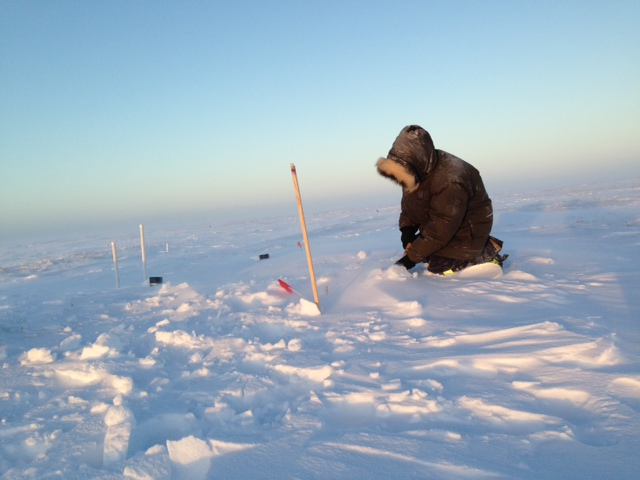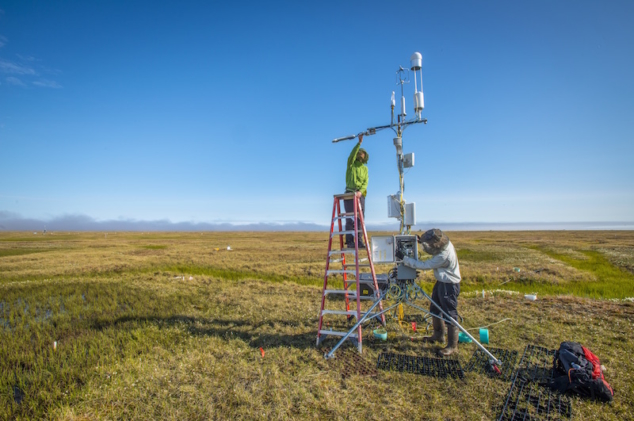When the frozen Arctic tundra starts to thaw around June of each year, the snow melting and the ground softening, the soil may release a large pulse of greenhouse gases, namely, carbon dioxide and methane. Little has been known about such releases.
Now scientists at the U.S. Department of Energy’s (DOE) Lawrence Berkeley National Laboratory, in collaboration with a team of other scientists taking measurements both in the field and in the lab, have quantified the scale of such releases and explained the underlying mechanisms for the phenomenon. Their study was based on a spring pulse in northern Alaska that they documented in 2014 that included CO2 emissions equivalent to 46 percent of the net CO2 that is absorbed in the summer months and methane emissions that added 6 percent to summer fluxes. What’s more, recent climate trends may make such emissions more frequent, the scientists conclude.
“We can see the effects of climate change happening more rapidly in the Arctic than in any other part of world,” said Berkeley Lab scientist Naama Raz-Yaseef. “So we need to understand the processes that are occurring and what to expect in the future. The amount of CO2 and methane (CH4) in the atmosphere determines the greenhouse effect—so we need to know more about these sources.”
Their study was recently published in the journal Geophysical Research Letters in a paper titled, “Large CO2 and CH4 Emissions from Polygonal Tundra During Spring Thaw in Northern Alaska.” Raz-Yaseef, an ecohydrologist, was the lead author. Co-authors were Berkeley Lab researchers Margaret Torn, Yuxin Wu, and Tim Kneafsey; Dave Billesbach of the University of Nebraska; Anna Liljedahl and Vladimir Romanovsky of the University of Alaska; David Cook of Argonne National Laboratory; and Stan Wullschleger of Oak Ridge National Laboratory.
The study was a project of DOE’s Next-Generation Ecosystem Experiment (NGEE-Arctic), which seeks to gain a predictive understanding of the Arctic terrestrial ecosystem’s feedback to climate. The team used two towers 4 meters high to collect gas flux readings. The towers are located about 5 km apart near Barrow, Alaska, the northernmost town in the U.S, one tower operated by NGEE and the other by DOE’s Atmospheric Radiation Measurement (ARM) Climate Research Facility.
“Typically we just measure what happens during summer,” RazYaseef said. “We assume nothing happens during winter because it’s frozen, so there’s no biological activity. But in 2014 we measured a big flux of carbon and methane emitted from the ground, at the very beginning of thaw and snowmelt. At first we didn’t know if it was real or a measurement error. Then we confirmed it with another tower 5 km away (the ARM tower), which measured a very similar flux of the same size during the same period.”
That spring they measured a total of three pulses, the longest lasting five days. These findings are important in understanding the carbon balance of ecosystems in the Arctic. So far, the Arctic is considered a carbon sink, meaning it absorbs more CO2 than it emits on an annual basis, thanks mainly to the vegetation that grows in the summer. (Oceans and forests are far larger carbon sinks.) “Given our findings, the Arctic is an even smaller carbon sink than we thought since during some years nearly half of the summer uptake of CO2 is offset with these spring emissions,” Raz-Yaseef said.
Gases trapped in the middle layer
Why is the soil releasing gases? Soils everywhere are full of microbes, and microbial activity emits gases. What makes the Arctic different is the way the ground freezes. As temperatures start to drop in the late fall, the soil freezes from the permafrost up and from the surface down. The active layer in between is trapped in the middle.
“For about a month after the surface freezes, the middle layer is still active,” Raz-Yaseef explained. “The temperature is still around 0 (Celsius), so microbial activity continues to take place, producing carbon and methane, but it’s trapped beneath the surface ice. It can’t be emitted, so it’s stored throughout the winter.”
When the ice cap thaws in spring, the gases escape to the atmosphere.
The scientists confirmed these observations in several ways. First, they measured soil temperatures every 10 cm down through the permafrost 1.5 meters below ground every 5 minutes year-round. Second, they extracted large, frozen soil cores that were transported to the laboratory for experiments.
“(Berkeley Lab scientist) Yuxin Wu thawed a core under controlled conditions, but just like in nature,” Raz-Yaseef said. “Just when the surface ice melted in the lab, he measured a large flux of carbon and methane. This is formed from gases trapped in the soil over winter.”
Separately, Berkeley Lab scientist Timothy Kneafsey took CT scans of hundreds of frozen cores and found gas-rich channels and pockets near the surface, which the scientists posited could serve as accumulation zones and pathways for gas flow.
Spring pulses not annual but may become more frequent
In fact, it’s these channels and pockets that enable the emission pulses, the scientists conclude in their paper. The spring pulses were not detected in 2013 or 2016, and 2015 could not be measured due to equipment malfunction. Since it’s not an annual event they analyzed the conditions under which the pulses might occur.
“The process is more likely to occur when there are events of rain on ice,” Raz-Yaseef said. “When it thaws and freezes repeatedly, that produces cracks in the frozen soil, and through these cracks the gas can be emitted.”
During warmer years, the scientists expect the spring pulses to be more frequent. “We expect there will be more gas built up due to longer and warmer fall seasons and more frequent pulse events due to more rain on ice in the spring,” Raz-Yaseef said.
One thing that’s for sure is the scientists now know not to ignore gas emissions in early spring. “Now we’ll put the towers up much, much earlier, just in case there’s another event, we’ll be sure to catch it,” Raz-Yaseef said. “It’s one of those things, once you’re aware of it, you open your eyes and looks for it.”
NGEE-Arctic is supported by the DOE Office of Science. ARM is a DOE Office of Science User Facility.
# # #
Lawrence Berkeley National Laboratory addresses the world’s most urgent scientific challenges by advancing sustainable energy, protecting human health, creating new materials, and revealing the origin and fate of the universe. Founded in 1931, Berkeley Lab’s scientific expertise has been recognized with 13 Nobel prizes. The University of California manages Berkeley Lab for the U.S. Department of Energy’s Office of Science. For more, visit www.lbl.gov.
DOE’s Office of Science is the single largest supporter of basic research in the physical sciences in the United States, and is working to address some of the most pressing challenges of our time. For more information, please visit science.energy.gov.


